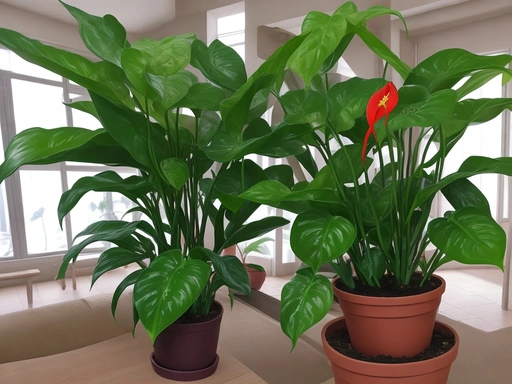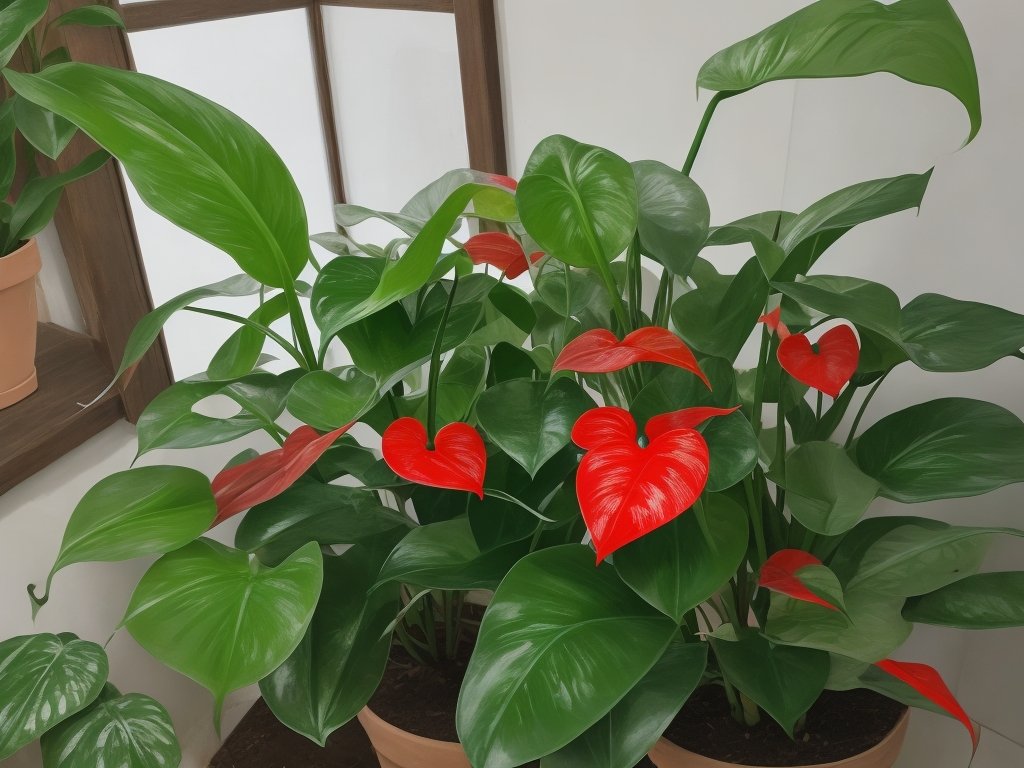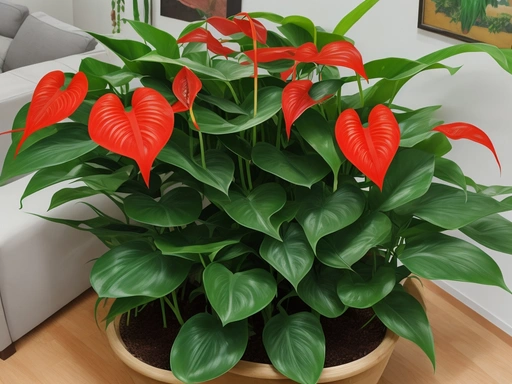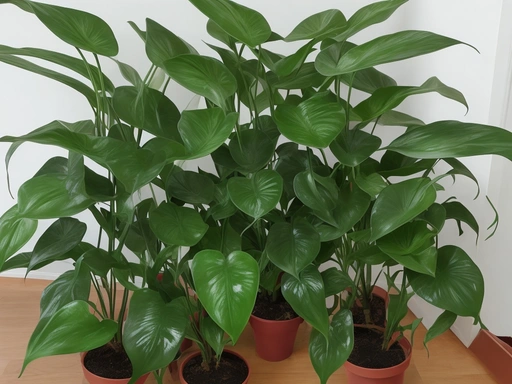Anthurium Fall Maintenance: Tips and Tricks for a Thriving Plant
Key Takeaways:
- Pruning dead or damaged leaves promotes healthier growth.
- Maintaining proper watering and humidity levels prevents wilted leaves.
- Fertilizing during the fall stimulates vibrant blooms.
- Regularly inspecting for pests helps prevent infestations and damage.
As the vibrant colors of summer fade away, it’s time to shift our attention to the fall maintenance of our beloved Anthurium plants. If you’re wondering how to keep your Anthuriums healthy and vibrant throughout the autumn season, you’ve come to the right place.
In this article, I’ll guide you through the essential steps for maintaining your Anthurium plants during fall.
From cleaning and pruning to adjusting light and temperature, watering and humidity guidelines, fertilizing, and preventing pests and diseases, we’ve got you covered. Let’s ensure your Anthuriums continue to blossom and thrive, even as the leaves outside begin to fall.
| Tasks | Frequency | Notes |
|---|---|---|
| Remove dead leaves and flowers | Regularly | Helps maintain plant health and appearance |
| Check for pests | Monthly | Look for signs of spider mites, aphids, or mealybugs |
| Repot the plant | Every 1-2 years | Use a well-draining potting mix |
| Adjust watering frequency | As needed | Reduce watering during the cooler months |
| Provide proper light | Consistently | Keep the plant in bright, indirect light |
| Fertilize | Monthly during active growth | Use a balanced liquid fertilizer according to package instructions |
| Check humidity levels | Regularly | Consider using a humidifier or misting the leaves |
| Monitor temperature | Consistently | Avoid exposing the plant to extreme temperatures |
Anthurium Fall Maintenance: Keeping Your Plants Healthy and Vibrant
Make sure to keep your Anthurium plants healthy and vibrant with proper fall maintenance.
Understanding Anthurium Plants
Anthurium plants are tropical flowering plants known for their striking, heart-shaped flowers.
They have glossy, dark green leaves, and some varieties have foliage with interesting patterns.
Anthuriums require warm temperatures and high humidity to thrive.
They can be grown as houseplants or in outdoor gardens with the right conditions.
Importance of Fall Maintenance for Anthurium Plants
Fall maintenance is crucial for Anthurium plants because it helps prevent damage and promotes healthy growth.
By cleaning and pruning, adjusting light and temperature, watering properly, and fertilizing as needed, we can ensure that our Anthurium plants thrive throughout the fall season.
Plus, it helps to prevent pests and diseases from affecting our plants.
So, don’t forget to give your Anthuriums some extra care during the fall!
Cleaning and Pruning Anthurium Plants
To clean and prune Anthurium plants, start by removing dead leaves and debris to promote healthy growth. If the foliage is overgrown or unhealthy, prune it back to maintain a neat appearance.
Clean the leaves by gently wiping them with a damp cloth to remove dust and dirt.
And don’t forget to regularly trim faded or wilted flowers to encourage new blooms.
Adjusting Light and Temperature for Fall
To adjust light and temperature for your Anthurium plants during fall, it’s important to understand their light requirements. Transition them to lower light levels gradually and avoid placing them near drafty windows or vents.
Maintain the optimum temperature range of 60-70°F (15-21°C) for healthy growth.

Watering and Humidity Guidelines for Fall
During the fall, it’s important to water your Anthurium plant regularly, but not excessively.
Allow the top inch of soil to dry out before watering again.
Aim to keep the soil consistently moist, but not soggy.
To maintain optimal humidity levels, mist the leaves regularly or place a humidifier nearby.
Avoid placing your Anthurium near drafts or heaters, as these can dry out the air and affect humidity.
Fertilizing Anthurium Plants in the Fall
Fertilizing Anthurium plants in the fall is important for their overall health and growth.
Choose a fertilizer with a balanced formula, such as 10-10-10, and apply it every two to three months.
Make sure to dilute the fertilizer before using it, and water your plants well after fertilization.
Avoid over-fertilizing, as it can harm the plant.
Fertilizing helps provide essential nutrients and promotes vibrant foliage and blooms.
Frequently Asked Questions
How often should I water my Anthurium plant in the fall?
– Water your Anthurium plant when the top inch of soil feels dry. Aim for deep watering rather than frequent shallow watering.
Can I prune an Anthurium plant during fall?
– Yes, you can prune your Anthurium plant in the fall. Remove any dead or overgrown foliage to maintain its health and appearance.
How do I prevent root rot in my Anthurium plant during fall?
– To prevent root rot, ensure that your Anthurium plant is in well-draining soil and avoid overwatering. Allow the soil to dry slightly between waterings.
What is the ideal temperature range for Anthurium plants in the fall?
– Anthurium plants thrive in temperatures between 65-85°F (18-29°C). Maintain a consistent temperature within this range to ensure their health and growth during the fall.

Understanding Anthurium Plants
Anthurium plants are unique and tropical, known for their colorful flowers and glossy leaves.
Understanding their key features, varieties, and ideal growing conditions will help you successfully care for these beautiful plants.
Key Features and Characteristics of Anthuriums
Anthuriums are tropical plants known for their vibrant, waxy flowers and glossy, heart-shaped leaves.
They come in various colors, including red, pink, white, and even green.
Anthuriums are also famous for their long-lasting blooms, making them a popular choice for indoor and outdoor gardens.
These plants thrive in warm and humid environments, and they can be grown as potted plants or planted in the ground.
Anthuriums are relatively easy to care for, and their unique features and striking appearance make them a stunning addition to any plant collection.
Different Varieties of Anthurium Plants
Anthurium plants come in a variety of colors and shapes. Some popular varieties include the Anthurium andraeanum, known for its heart-shaped red or pink flowers, and the Anthurium scherzerianum, which has bright red spathes and yellow spadices.
There are also green, white, and purple varieties available, each with their own unique features.
Ideal Conditions for Anthurium Growth
Anthurium plants thrive under these ideal conditions:
- Bright, indirect light: Place them near a window with filtered sunlight.
- Warm temperatures: Maintain a range of 70-90°F (21-32°C.
- Well-draining soil: Use a mixture of peat moss, perlite, and orchid bark.
- Moderate humidity: Aim for 50-60% humidity levels.
- Regular watering: Keep the soil evenly moist, but avoid overwatering.
- Proper fertilization: Feed every 2-4 weeks during the growing season.
- Avoid drafts and extreme temperatures: Protect the plants from cold drafts or sudden temperature fluctuations.
- Space for growth: Provide enough room for the plant to flourish and spread its leaves.
- Clean environment: Dust the leaves regularly and remove any dead foliage.
Importance of Fall Maintenance for Anthurium Plants
Proper fall maintenance is essential for Anthurium plants. It helps keep them healthy and thriving throughout the year.
Why Fall Maintenance is Essential for Anthuriums
Fall maintenance is essential for Anthuriums because it helps promote healthy growth and prevents potential problems.
Cleaning and pruning remove dead leaves and debris, ensuring good air circulation.
Adjusting light and temperature for fall mimics their natural environment.
Proper watering and humidity levels keep them hydrated.
Fertilizing provides essential nutrients.
Preventing pests and diseases safeguards their well-being.
Regular maintenance in the fall sets the stage for vibrant and thriving Anthurium plants.

Benefits of Proper Fall Maintenance
Proper fall maintenance for Anthurium plants brings several benefits.
It helps prevent damage and promotes healthy growth.
Fall cleaning and pruning remove dead leaves and debris, ensuring optimal plant health.
Adjusting light and temperature levels helps the plants adjust to lower light and maintain the ideal temperature.
Proper watering and humidity management during fall prevent overwatering and root rot.
Fertilizing in the fall provides essential nutrients for robust growth.
Lastly, proactive pest prevention and disease management keep Anthurium plants thriving.

Preventing Damage and Promoting Growth in the Fall
Preventing damage and promoting growth in the fall for Anthurium plants is crucial. Remove dead leaves, prune overgrown foliage, and clean leaves gently.
Transition to lower light levels, maintain optimum temperature, and adjust watering accordingly.
Fertilize with a balanced formula. Monitor for pests and diseases, taking preventive measures.
Cleaning and Pruning Anthurium Plants
Cleaning and pruning your Anthurium plants is essential for their health and appearance.
Removing Dead Leaves and Debris
To remove dead leaves and debris from your Anthurium plant, simply use your fingers or a clean pair of scissors to gently detach them from the plant.
Be careful not to damage any healthy leaves or stems in the process.
Regularly removing dead foliage will help keep your plant looking tidy and prevent the spread of diseases.
It’s also a good opportunity to check for any signs of pests or other issues that may require attention.
Remember to dispose of the removed leaves and debris properly to avoid any potential contamination.
Pruning Overgrown or Unhealthy Foliage
To prune overgrown or unhealthy foliage on your Anthurium plant, start by identifying the damaged or unproductive leaves. Use sharp, clean pruning shears to carefully remove these leaves at the base, making clean cuts.
It’s important to remove any dead, yellowed, or decaying foliage, as well as any leaves with pest damage.
Pruning helps improve the plant’s appearance and overall health. Remember to disinfect your pruning tools before and after each use to prevent the spread of diseases.
How to Properly Clean Anthurium Leaves
To properly clean Anthurium leaves, gently wipe them with a damp cloth or sponge. Avoid using any chemicals or cleaning products, as they can harm the leaves.
Remove any dust or dirt buildup, paying attention to both sides of the leaves.
Regular cleaning will keep your Anthurium plants healthy and looking their best.
Tips for Maintaining Anthurium Flowers
To maintain Anthurium flowers, it’s important to:
- Keep the flowers in bright, indirect light.
- Water them regularly, but don’t let the soil become waterlogged.
- Maintain a moderate humidity level by misting the leaves occasionally.
- Fertilize the plants monthly with a balanced fertilizer.
- Remove any dead or yellowing leaves and prune overgrown foliage.
- Prevent pests by regularly inspecting and treating the plants if necessary.
Adjusting Light and Temperature for Fall
To ensure your Anthurium plants thrive in the fall, it’s important to adjust their light and temperature levels.
This means understanding their light requirements, transitioning them to lower light levels, and maintaining optimal temperatures.
Understanding Anthurium Light Requirements
Understanding Anthurium Light Requirements is essential for keeping these plants healthy.
They thrive in bright, indirect light, so place them near a north or east-facing window.
Avoid direct sunlight, as it can scorch their leaves.
If your Anthurium isn’t flowering, it may need more light.
Experiment with different locations until you find the right balance.
Transitioning Anthurium Plants to Lower Light Levels in the Fall
As fall approaches, it’s important to transition your Anthurium plants to lower light levels.
Start by gradually moving them away from direct sunlight.
Place them in a location with bright indirect light.
Avoid exposing them to extreme temperature changes.
This will help your Anthuriums adjust and thrive during the fall season.
Maintaining Optimum Temperature for Anthuriums during Fall
Maintain a temperature between 60-70°F (15-21°C) for Anthuriums during fall.
Avoid exposing them to cold drafts or temperatures below 50°F (10°C) as it can damage their leaves and slow down growth.
Place them in a warm and well-insulated area to ensure they thrive during this season.
Watering and Humidity Guidelines for Fall
During the fall season, it’s important to adjust your watering and humidity levels for your Anthurium plants.
Fall Watering Needs for Anthurium Plants
During fall, it’s important to adjust the watering routine for your Anthurium plants. Start by monitoring the soil moisture levels and water only when the top inch of soil feels dry.
Avoid overwatering to prevent root rot.
Remember, Anthuriums prefer to be slightly on the drier side rather than consistently wet.
Monitoring Soil Moisture Levels
To monitor soil moisture levels for your Anthurium plants in the fall, you can use a moisture meter or simply check the soil with your finger.
Stick the moisture meter about 2 inches deep into the soil, or insert your finger up to the second knuckle.
If the soil feels dry, it’s time to water.
If it feels moist, wait a bit longer.
Remember, overwatering can be just as harmful as underwatering, so it’s important to find the right balance.
Managing Humidity for Anthuriums during Fall
Managing humidity for Anthuriums during fall is important to maintain their health. Here’s what you can do:
- Increase humidity levels: Use a humidifier or place your plants on a tray filled with water and pebbles to create a humid microclimate.
- Group plants together: This helps create a natural humid environment as plants release moisture through transpiration.
- Mist your plants: Spraying water on the leaves helps increase humidity temporarily.
- Avoid dry air sources: Keep your plants away from heaters or vents that can dry out the air around them.
- Use a pebble tray: Placing your potted Anthurium on a tray with water and pebbles can help increase humidity around the plant.
Remember, proper humidity levels are vital for your Anthurium’s well-being, especially during the dry fall months.
Tips for Properly Watering Anthurium Plants
To properly water your Anthurium plants, follow these tips:
- Water when the top inch of soil feels dry. Stick your finger into the soil and if it feels dry, it’s time to water.
- Use room temperature water. Cold water can shock the roots and cause stress to the plant.
- Water thoroughly until water drains out of the bottom of the pot. This ensures that the entire root system gets hydrated.
- Avoid overwatering. Anthuriums prefer slightly moist soil, not soggy conditions.
- Don’t let the plant sit in standing water. Empty excess water from the saucer to prevent root rot.
- Consider using a well-draining potting mix to prevent waterlogged soil.
Remember, every plant is unique, so adjust your watering schedule based on the specific needs of your Anthurium.
Fertilizing Anthurium Plants in the Fall
Fertilizing Anthurium Plants in the Fall helps maintain their health and promote better growth during the winter season. Choosing the right fertilizer and fertilizing method is important for ensuring the proper nutrition of your Anthurium plants in the fall.
Importance of Fertilizing Anthuriums in the Fall
Fertilizing Anthurium plants in the fall is crucial to their health and overall growth. It provides essential nutrients that they need during this time of year.
Fertilization promotes strong root development, lush foliage, and vibrant blooms.
By fertilizing in the fall, you ensure that your Anthuriums have the nutrients they need to thrive throughout the season.
Choosing the Right Fertilizer for Anthuriums
Choosing the right fertilizer for Anthuriums is important for their overall health and growth.
Look for a balanced fertilizer with a ratio of NPK (nitrogen, phosphorus, and potassium) of 10-10-10 or 14-14-14.
Avoid fertilizers high in nitrogen, as it can lead to excessive foliage growth and fewer flowers.
Organic options like fish emulsion or compost can also be beneficial.
Remember to follow the package instructions for application rates and frequency.
Frequency and Method of Fertilization in the Fall
During the fall, fertilize your Anthurium plants once every 4-6 weeks. Use a balanced fertilizer with a ratio of 10-10-10 or 20-20-20.
Apply the fertilizer according to the package instructions, making sure to water the plants before and after fertilizing.
Avoid over-fertilization, as it can cause burns and damage the plant.
Preventing Pests and Diseases
Preventing pests and diseases is essential for the health of your Anthurium plants.
Common Pests that Affect Anthurium Plants
Anthurium plants can be affected by common pests such as aphids, mealybugs, spider mites, and thrips. These pests can cause damage by feeding on the leaves, sucking out sap, and leaving behind a sticky residue.
To treat an infestation, you can use insecticidal soap or neem oil, and regularly inspect your plants for signs of pests.
Identifying and Treating Anthurium Plant Diseases
Identifying and treating Anthurium plant diseases is important for keeping your plants healthy.
Some common diseases include root rot, leaf spot, and fungal infections.
To identify these diseases, look for symptoms like yellowed or wilting leaves, dark spots, or moldy growth.
Treatments may include improving drainage, adjusting watering practices, or applying fungicides.
It’s important to act quickly to prevent the spread of diseases and maintain the overall health of your Anthurium plants.
Preventive Measures for Pesky Anthurium Pests
To prevent pesky pests from wreaking havoc on your Anthurium plants, here are some preventive measures you can take:
- Regularly inspect your plants for any signs of pests such as aphids, mealybugs, or spider mites. Catching the problem early can help prevent it from spreading.
- Keep your plants clean by wiping the leaves with a damp cloth or using a gentle spray of water to remove dust and debris. This can discourage pests from settling in.
- Use organic insecticidal soap or neem oil to treat infestations. These options are less harmful to the plant and environment.
- Quarantine new plants before introducing them to the rest of your collection. This can help prevent the spread of pests to healthy plants.
- Keep your gardening tools clean and sanitized to avoid cross-contamination between plants.
- Provide good airflow and proper spacing between plants to prevent the buildup of moisture, which can attract pests.
- Avoid overwatering your Anthuriums, as excessive moisture can create an environment suitable for pests and diseases.
- Use a well-draining soil mix to prevent root rot, which can make your plants more susceptible to pests.
- Lastly, regularly monitor and maintain the overall health of your Anthuriums. Healthy plants are naturally more resistant to pest infestations.
By implementing these preventive measures, you can keep your Anthurium plants thriving and free from pesky pests.
Frequently Asked Questions
How often should I water my Anthurium plant in the fall?
In the fall, you should water your Anthurium plant whenever the top inch of soil feels dry to the touch. Be sure to check the moisture level regularly as the changing weather conditions can affect how quickly the soil dries out.
Avoid overwatering to prevent root rot.
Can I prune an Anthurium plant during fall?
Yes, you can prune an Anthurium plant during fall.
It’s actually a good time to do so because pruning helps promote new growth and keeps the plant healthy.
Just make sure to remove any dead or damaged leaves, and trim any overgrown or unhealthy foliage.
This will keep your Anthurium looking beautiful and vibrant throughout the season.
How do I prevent root rot in my Anthurium plant during fall?
To prevent root rot in your Anthurium plant during fall, make sure to adjust your watering routine.
Avoid overwatering and allow the soil to dry out slightly between waterings.
Ensure proper drainage by using a well-draining potting mix and a container with drainage holes.
Additionally, avoid placing the plant in areas with excessive humidity or stagnant air.
What is the ideal temperature range for Anthurium plants in the fall?
The ideal temperature range for Anthurium plants in the fall is between 65°F to 75°F (18°C to 24°C). It’s important to avoid extreme temperature fluctuations and keep the plants away from cold drafts.
Providing a consistent and moderately warm environment will promote healthy growth and prevent stress to the plant.
Final Verdict
Fall maintenance is crucial for keeping your Anthurium plants healthy and vibrant.
By understanding the key features and characteristics of Anthuriums, adjusting light and temperature, properly cleaning and pruning, watering and fertilizing, and preventing pests and diseases, you can ensure optimal growth and prevent damage during the fall season.
Remember to regularly monitor and provide the necessary care for your Anthurium plants to promote their overall well-being.
With these tips and guidelines, you can enjoy beautiful Anthurium plants that thrive throughout the fall and beyond.






